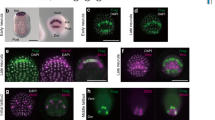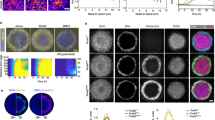Abstract
Early in differentiation, all neural cells have a rostral character. Only later do posteriorly positioned neural cells acquire characteristics of caudal forebrain, midbrain and hindbrain cells. Caudalization of neural tissue in the chick embryo apparently involves the convergent actions of (i) fibroblast growth factor (FGF) signaling and (ii) signaling from the caudal paraxial mesoderm, or 'PMC activity', which has not yet been defined molecularly. Here we report evidence that Wnt signaling underlies PMC activity, and show that Wnt signals act directly and in a graded manner on anterior neural cells to induce their progressive differentiation into caudal forebrain, midbrain and hindbrain cells.
This is a preview of subscription content, access via your institution
Access options
Subscribe to this journal
Receive 12 print issues and online access
$209.00 per year
only $17.42 per issue
Buy this article
- Purchase on Springer Link
- Instant access to full article PDF
Prices may be subject to local taxes which are calculated during checkout







Similar content being viewed by others
Change history
11 June 2002
Linked asterisk added to the phrase "rostral-to-caudal shift" -- the footnote reads: The authors wish to correct the phrase "rostral-to-caudal shift," which should read "rostrocaudal shift." An erratum will be published in the July issue.
Notes
NOTE: The authors wish to correct the phrase "rostral-to-caudal shift," which should read "rostrocaudal shift."
References
Lumsden, A. & Krumlauf, R. Patterning the vertebrate neuraxis. Science 274, 1109–1115 (1996).
Stern, C. D. Initial patterning of the central nervous system: how many organizers? Nat. Rev. Neurosci. 2, 92–98 (2001).
Nieuwkoop, P. D. et al. Activation and organisation of the central nervous system in amphibians. J. Exp. Zool. 1–108 (1952).
Muhr, J., Graziano, E., Wilson, S., Jessell, T. M. & Edlund, T. Convergent inductive signals specify midbrain, hindbrain and spinal cord identity in gastrula stage chick embryos. Neuron 23, 689–702 (1999).
Muhr, J., Jessell, T. M. & Edlund, T. Assignment of early caudal identity to neural plate cells by a signal from caudal paraxial mesoderm. Neuron 19, 487–502 (1997).
Storey, K. G. et al. Early posterior neural tissue is induced by FGF in the chick embryo. Development 125, 473–484 (1998).
Domingos, P. M. et al. The Wnt/β-catenin pathway posteriorizes neural tissue in Xenopus by an indirect mechanism requiring FGF signaling. Dev. Biol. 239, 148–160 (2001).
Maden, M. Heads or tails? Retinoic acid will decide. Bioessays 21, 809–812 (1999).
Niederreither, K., Vermot, J., Schuhbaur, B., Chambon, P. & Dolle, P. Retinoic acid synthesis and hindbrain patterning in the mouse embryo. Development 127, 75–85 (2000).
Liu, J. P., Laufer, E. & Jessell, T. M. Assigning the positional identity of spinal motor neurons. Rostrocaudal patterning of Hox-c expression by FGFs, Gdf11 and retinoids. Neuron 32, 997–1012 (2001).
Woo, K. & Fraser, S. E. Specification of the zebrafish nervous system by nonaxial signals. Science 277, 254–257 (1997).
Bang, A. G., Papalopulu, N., Kintner, C. & Goulding, M. D. Expression of Pax-3 is initiated in the early neural plate by posteriorizing signals produced by the organizer and by posterior non-axial mesoderm. Development 124, 2075–2085 (1997).
Erter, C. E., Wilm, T.P., Basler, N., Wright, C. V. & Solnica-Krezel, L. Wnt8 is required in lateral mesendodermal precursors for neural posteriorization in vivo. Development 128, 3571–3583 (2001).
Hume, C. R. & Dodd, J. Cwnt-8C: a novel Wnt gene with a potential role in primitive streak formation and hindbrain organization. Development 119, 1147–1160 (1993).
Baranski, M., Berdougo, E., Sandler, J. S., Darnell, D. K. & Burrus, L. W. The dynamic expression pattern of frzb-1 suggests multiple roles in chick development. Dev. Biol. 217, 25–41 (2000).
Yamaguchi, T. P. Heads or tails: Wnts and anterior-posterior patterning. Curr. Biol. 11, R713–724 (2001).
McGrew, L. L., Hoppler, S. & Moon, R. T. Wnt and FGF pathways cooperatively pattern anteroposterior neural ectoderm in Xenopus. Mech. Dev. 69, 105–114 (1997).
Fredieu, J. R., Cui, Y., Maier, D., Danilchik, M. V. & Christian, J. L. Xwnt-8 and lithium can act upon either dorsal mesodermal or neurectodermal cells to cause a loss of forebrain in Xenopus embryos. Dev. Biol. 186, 100–114 (1997).
Popperl, H. et al. Misexpression of Cwnt8C in the mouse induces an ectopic embryonic axis and causes a truncation of the anterior neuroectoderm. Development 124, 2997–3005 (1997).
Bang, A.G., Papalopulu, N., Goulding, M.D. & Kintner, C. Expression of Pax-3 in the lateral neural plate is dependent on a Wnt-mediated signal from posterior nonaxial mesoderm. Dev. Biol. 212, 366–380 (1999).
Liu, P. et al. Requirement for Wnt3 in vertebrate axis formation. Nat. Genet. 22, 361–365 (1999).
Huelsken, J. et al. Requirement for β-catenin in anterior-posterior axis formation in mice. J. Cell Biol. 148, 567–578 (2000).
Fekany-Lee, K., Gonzalez, E., Miller-Bertoglio, V. & Solnica-Krezel, L. The homeobox gene bozozok promotes anterior neuroectoderm formation in zebrafish through negative regulation of BMP2/4 and Wnt pathways. Development 127, 2333–2345 (2000).
Kiecker, C. & Niehrs, C. A morphogen gradient of Wnt/β-catenin signaling regulates anteroposterior neural patterning in Xenopus. Development 128, 4189–4201 (2001).
Heisenberg, C. P. et al. A mutation in the Gsk3-binding domain of zebrafish Masterblind/Axin1 leads to a fate transformation of telencephalon and eyes to diencephalon. Genes Dev. 15, 1427–1434 (2001).
Mukhopadhyay, M. et al. Dickkopf1 is required for embryonic head induction and limb morphogenesis in the mouse. Dev. Cell 1, 423–434 (2001).
van de Water, S. et al. Ectopic Wnt signal determines the eyeless phenotype of zebrafish masterblind mutant. Development 128, 3877–3888 (2001).
Greco, T. L. et al. Analysis of the vestigial tail mutation demonstrates that Wnt-3a gene dosage regulates mouse axial development. Genes Dev. 10, 313–324 (1996).
Lekven, A. C., Thorpe, C. J., Waxman, J. S. & Moon, R. T. Zebrafish wnt8 encodes two wnt8 proteins on a bicistronic transcript and is required for mesoderm and neurectoderm patterning. Dev. Cell 1, 103–114 (2001).
Yoshikawa, Y., Fujimori, T., McMahon, A. P. & Takada, S. Evidence that absence of Wnt-3a signaling promotes neuralization instead of paraxial mesoderm development in the mouse. Dev. Biol. 183, 234–242 (1997).
Takada, S. et al. Wnt-3a regulates somite and tailbud formation in the mouse embryo. Genes Dev. 8, 174–189 (1994).
Eisenberg, C. A., Gourdie, R. G. & Eisenberg, L. M. Wnt-11 is expressed in early avian mesoderm and required for the differentiation of the quail mesoderm cell line QCE-6. Development 124, 525–536 (1997).
Rex, M. et al. Dynamic expression of chicken Sox2 and Sox3 genes in ectoderm induced to form neural tissue. Dev. Dyn. 209, 323–332 (1997).
Mallamaci, A., Di Blas, E., Briata, P., Boncinelli, E. & Corte, G. OTX2 homeoprotein in the developing central nervous system and migratory cells of the olfactory area. Mech. Dev. 58, 165–178 (1996).
Bell, E., Ensini, M., Gulisano, M. & Lumsden, A. Dynamic domains of gene expression in the early avian forebrain. Dev. Biol. 236, 76–88 (2001).
Matsunaga, E., Araki, I. & Nakamura, H. Pax6 defines the di-mesencephalic boundary by repressing En1 and Pax2. Development 127, 2357–2365 (2000).
Davis, C. A. & Joyner, A. L. Expression patterns of the homeo box-containing genes En-1 and En-2 and the proto-oncogene int-1 diverge during mouse development. Genes Dev. 2, 1736–1744 (1988).
Shamim, H. & Mason, I. Expression of Gbx-2 during early development of the chick embryo. Mech. Dev. 76, 157–159 (1998).
Nieto, M. A., Bradley, L. C. & Wilkinson, D. G. Conserved segmental expression of Krox-20 in the vertebrate hindbrain and its relationship to lineage restriction. Development Suppl. 2, 59–62 (1991).
Hsieh, J. C., Rattner, A., Smallwood, P. M. & Nathans, J. Biochemical characterization of Wnt–frizzled interactions using a soluble, biologically active vertebrate Wnt protein. Proc. Natl. Acad. Sci. USA 96, 3546–3551 (1999).
Wilson, S. et al. The status of Wnt signaling regulates neural and epidermal fates in the chick embryo. Nature 411, 325–330 (2001).
New, D. A. A new technique for the cultivation of the chick embryo in vitro. J. Embryol. Exp. Morphol. 3, 320–331 (1955).
Shibamoto, S. et al. Cytoskeletal reorganization by soluble Wnt-3a protein signaling. Genes Cells 3, 659–670 (1998).
Niehrs, C. Head in the WNT: the molecular nature of Spemann's head organizer. Trends Genet. 15, 314–319 (1999).
Foley, A. C., Skromne, I. & Stern, C. D. Reconciling different models of forebrain induction and patterning: a dual role for the hypoblast. Development 127, 3839–3854 (2000).
Foley, A. C., Storey, K. G. & Stern, C. D. The prechordal region lacks neural inducing ability, but can confer anterior character to more posterior neuroepithelium. Development 124, 2983–2996 (1997).
Gould, A., Itasaki, N. & Krumlauf, R. Initiation of rhombomeric Hoxb4 expression requires induction by somites and a retinoid pathway. Neuron 21, 39–51 (1998).
Jessell, T. M. Neuronal specification in the spinal cord: inductive signals and transcriptional codes. Nat. Rev. Genet. 1, 20–29 (2000).
Schaeren-Wiemers, N. & Gerfin-Moser, A. A single protocol to detect transcripts of various types and expression levels in neural tissue and cultured cells: in situ hybridization using digoxigenin-labelled cRNA probes. Histochemistry 100, 431–440 (1993).
Yamada, T., Placzek, M., Tanaka, H., Dodd, J. & Jessell, T. M. Control of cell pattern in the developing nervous system: polarizing activity of the floor plate and notochord. Cell 64, 635–647 (1991).
Acknowledgements
We thank Y. Renoncourt for experimental contributions, members of the Edlund lab for discussions and H. Alstermark for technical assistance. We are grateful to R. Nusse for providing Wnt3A-expressing cells, to J. Nathans for the mFrzCRD-IgG plasmid and Xwnt8 cell line and to C. Tabin for Wnt probes. T.E. is supported by the Swedish Medical Research Council and by the Foundation for Strategic Research. T.M.J. is supported by grants from US National Institute of Neurological Disorders and Stroke (NIH-NINDS) and is an Investigator of the Howard Hughes Medical Institute.
Author information
Authors and Affiliations
Corresponding author
Ethics declarations
Competing interests
The authors declare no competing financial interests.
Rights and permissions
About this article
Cite this article
Nordström, U., Jessell, T. & Edlund, T. Progressive induction of caudal neural character by graded Wnt signaling. Nat Neurosci 5, 525–532 (2002). https://doi.org/10.1038/nn0602-854
Received:
Accepted:
Published:
Issue Date:
DOI: https://doi.org/10.1038/nn0602-854
This article is cited by
-
Deciphering and reconstitution of positional information in the human brain development
Cell Regeneration (2021)
-
Generation of extracellular morphogen gradients: the case for diffusion
Nature Reviews Genetics (2021)
-
Hindbrain induction and patterning during early vertebrate development
Cellular and Molecular Life Sciences (2019)
-
A novel gene’s role in an ancient mechanism: secreted Frizzled-related protein 1 is a critical component in the anterior–posterior Wnt signaling network that governs the establishment of the anterior neuroectoderm in sea urchin embryos
EvoDevo (2018)
-
Wnt signal activation induces midbrain specification through direct binding of the beta-catenin/TCF4 complex to the EN1 promoter in human pluripotent stem cells
Experimental & Molecular Medicine (2018)



